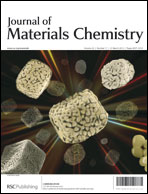Porous V2O5 micro/nano-tubes: Synthesis via a CVD route, single-tube-based humidity sensor and improved Li-ion storage properties
Abstract
Porous V2O5 micro/nano-tubes were synthesized via a modified chemical vapor deposition process and a possible growth mechanism was proposed. The micro/nano-tubes have large surface area because of their tubular structure with a porous wall. A humidity sensor based on a single porous V2O5 micro/nano-tube was constructed, and humidity sensing measurements indicated fast response/recovery. Due to the large surface area, the porous V2O5 micro/nano-tubes were used as a cathode material for lithium-ion batteries that exhibited great improvement of the electrochemical performance such as a high lithium-storage capacity of ∼290 mA h g−1, excellent cycling stability and reversibility. Further


 Please wait while we load your content...
Please wait while we load your content...